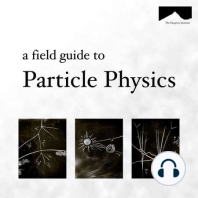2 min listen
The Neutral Kaons
ratings:
Length:
7 minutes
Released:
Feb 4, 2022
Format:
Podcast episode
Description
The Field Guide to Particle Physics : Season 2https://pasayten.org/the-field-guide-to-particle-physics©2022 The Pasayten Institute cc by-sa-4.0The definitive resource for all data in particle physics is the Particle Data Group: https://pdg.lbl.gov.The Pasayten Institute is on a mission to build and share physics knowledge, without barriers! Get in touch.The Neutral KaonsBefore we can describe neutral kaons in the wild, we need to take a quick detour to the city.South of Downtown Seattle resides the historic Pioneer Square. Bricks line the sidewalks and the ends of metal, reinforcement bars stick out of the old, stone buildings. Approaching the iconic Smith Tower, you cross Yesler Way, and something happens. The direction of the streets change.South of Yesler, the streets all run north-south. The grid, in other words, matches the cardinal points of the compass: north south, east west. When you cross Yesler, confusingly, everything rotates by 45 degrees.The streets of downtown Seattle - between Yesler Way and Denny Way - all point Northwest. The rotation of streets is made to match the contour of Elliot Bay. The waterfront goes NW to SE. Streets run parallel and perpendicular to it.It’s often easier for us to think in terms of north south east west, but sometimes the geographic features of the terrain forces a change. There are still two directions, it’s just a shift in our frame of reference.This idea of a 45-degree shift in our frame of reference, mixing North with West and South with East, is very similar to how the neutral kaons behave.Introducing the Neutral KaonsThere are two, electrically neutral kaons. K0 and K0bar. Like the eta and eta prime mesons - which are also electrically neutral - these neutral kaons are mesons that include a strange quark.The strange quark is like the down quark, only quite a bit heavier. Because it’s heavier, the particles comprised of them like the kaons, also tend to be heavier.Mesons - like the kaons - are quark molecules made from one quark and one antiquark. The strange quark is a heavy version of the down quark, and so both have an electric charge of -1/3. Neutral kaons are combinations of to quark-antiquark pairs: down-antiStrange and strange-antiDown. These two combinations are called K0 and K0bar, respectively.With masses just shy of 500 MeV, these neutral kaons are heavy. Unlike the heavy and short-lived eta and eta prime mesons, the lifetime of these neutral kaons is considerably longer. Like the Lambda zero baryon, the strange quark makes it difficult for the neutral kaons to decay. How they decay brings us back to the streets of Seattle.The Long and Short of itThe charged kaons presented a mystery because they could decay to both three pions and two pions. This confused particle physicists for quite some time. Neutral kaons also share this curious property, with nuance, of course.Like the street map of Seattle, K0 and K0bar mix. While moving through space, a K0 can spontaneously change into a K0bar and vice versa. This mixing is something of an artifact of an even stranger phenomena. Strictly speaking, neither the K0 nor K0bar mesons interact with Weak nuclear force. Only mixtures of them interact the W bosons. Just like North and East can combine to Northwest and Northeast, we think of these kaon combinations as K0 plus K0bar or K0 minus K0bar. It’s like a rotation by plus or minus 45 degrees.How is the possible? In a word, Quantum Mechanics. You might say that the Strong nuclear force - the thing that binds quarks together into bigger particles - respects the individual identities of those quarks: up, down and strange. The Weak nuclear force, however, does not. These particle-antiparticle oscillations are similar to the flavor oscillations experienced by the three flavors of neutrini. The “minus” combination is sometimes called K-short, because it decays relatively quickly: just shy of 8 percent of a nanosecond. The “plus” combination is sometimes called K-long, which takes 50 n
Released:
Feb 4, 2022
Format:
Podcast episode
Titles in the series (49)
The Electron: The electron is arguably the most famous of the elementary particles. They are the business end of the atom, and their dynamics give rise to virtually all of chemistry. They’re also the basic working particle of electricity, and their presence or absence by The Field Guide to Particle Physics
